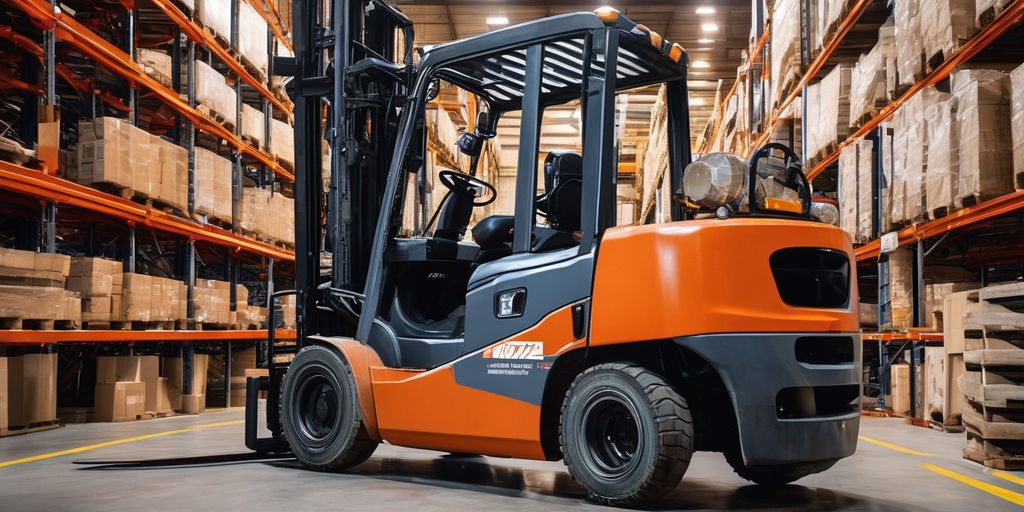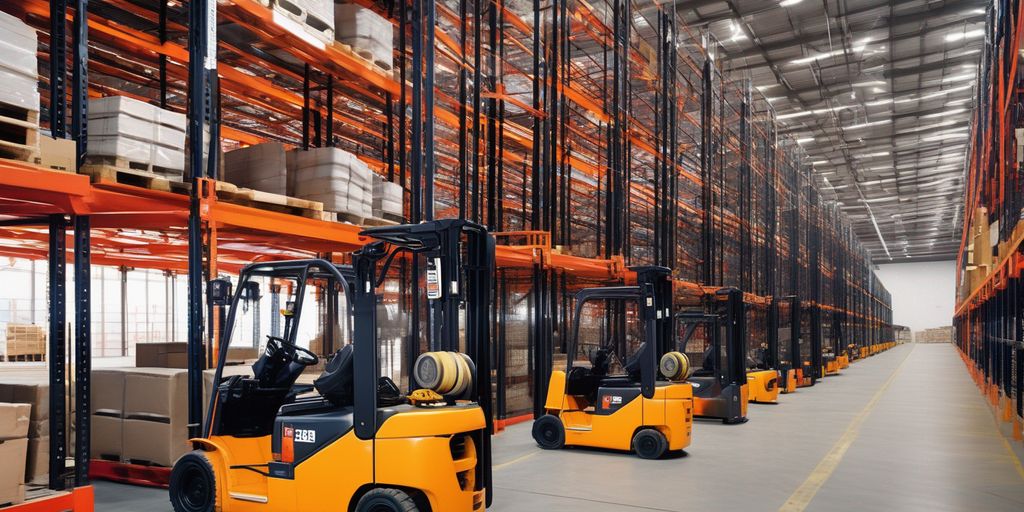Forklift Battery Maintenance: Tips for Prolonging Battery Life — overview
Forklift battery maintenance is crucial for ensuring the longevity and efficiency of electric forklifts. This article offers comprehensive tips on how to maintain forklift batteries effectively, covering various aspects from basic understanding and charging practices to advanced care and troubleshooting. By adhering to these guidelines, operators can enhance battery performance and extend its lifespan, thereby optimizing the overall productivity and reducing costs associated with battery replacements and forklift downtime.
Key Takeaways
- Understand the different types of forklift batteries and their specific maintenance needs to ensure proper care.
- Implement correct charging techniques and avoid overcharging to maximize battery life.
- Regularly clean battery terminals and check fluid levels to prevent performance degradation.
- Consider environmental factors such as temperature and humidity when storing and using forklift batteries.
- Invest in training for operators on proper battery handling and safety measures to prevent accidents and ensure optimal battery performance.
Understanding Forklift Battery Basics
 forklift battery maintenance workshop">
forklift battery maintenance workshop">
Types of Forklift Batteries
Forklift batteries come in various types, each suited for different operational needs. The most common types include lead-acid and lithium-ion batteries. Lead-acid batteries are known for their robustness and cost-effectiveness, while lithium-ion batteries offer a higher energy density and faster charging times.
Importance of Regular Maintenance
Regular maintenance is crucial for ensuring the longevity and efficiency of forklift batteries. It involves routine checks and corrective measures to prevent common issues such as sulfation and corrosion, which can significantly impair battery performance.
Identifying Common Battery Issues
Early identification of battery issues can prevent costly repairs and downtime. Common problems include voltage irregularities, decreased capacity, and physical damage. Regular inspections and performance tests are essential to maintain optimal battery health.
Optimal Charging Practices

Choosing the Right Charger
Selecting the appropriate charger for your forklift battery is crucial. It should match the battery's voltage and capacity to ensure efficient charging and prevent damage. Always verify compatibility between the battery and charger to optimize performance and extend the battery's lifespan.
Correct Charging Techniques
Proper charging techniques are essential for maintaining battery health. Follow these steps to ensure optimal charging:
- Only charge the battery when it falls below 30% capacity.
- Ensure the charger and forklift are turned off before connecting the battery.
- Keep the battery compartment and cover open during charging to prevent overheating.
- Use fans in extreme environments to control temperature.
- Follow the manufacturer's recommended charging practices.
Avoiding Overcharging
Overcharging a forklift battery can significantly reduce its lifespan. To avoid this, use a charger with an automatic shut-off feature. Additionally, schedule regular equalization charges to maintain battery balance and prevent the buildup of sulphation on the plates.
Routine Maintenance Procedures

Cleaning Battery and Terminals
Regular cleaning of the battery and terminals is essential to prevent corrosion and ensure efficient operation. Use a solution of baking soda and water to clean the terminals, and make sure to dry them thoroughly to avoid any short circuits.
Checking and Topping Up Fluid Levels
Maintaining proper fluid levels is crucial for battery longevity. Check the electrolyte levels monthly and top up with distilled water when necessary. Avoid using tap water as it can contain minerals that harm the battery.
Scheduling Regular Inspections
To ensure your forklift battery remains in optimal condition, schedule regular inspections as part of your maintenance routine. This will help identify potential issues before they become major problems, contributing to the safe procedures and sustainability of your operations.
Regular maintenance not only prolongs the life of the battery but also enhances the overall efficiency and safety of the forklift.
Environmental Considerations

Temperature and Humidity Effects
Temperature and humidity are critical factors in maintaining the health of forklift batteries. It's essential to keep batteries at a safe temperature, ideally not exceeding 113°F, to prolong their life. Ensure adequate air circulation around the battery compartment for optimal cooling. High humidity levels can also accelerate corrosion, so maintaining a controlled environment is crucial.
Proper Storage Conditions
Storing your forklift batteries in the right conditions is vital for their longevity. The storage area should be clean, dry, and well-ventilated. Avoid exposing batteries to extreme temperatures, which can cause damage and reduce efficiency. Regular checks for wear and damage are also recommended to ensure safe storage.
Handling Spills and Leaks
When dealing with battery spills or leaks, safety should be your top priority. Use personal protective equipment (PPE) such as safety glasses and gloves. Quickly contain and neutralize spills to prevent damage and ensure the safety of the workspace. Regular inspections can help identify potential risks early, reducing the chances of spills and leaks.
Note: Always follow recommended safety protocols and emergency procedures when handling forklift batteries to ensure a safe working environment.
Advanced Care Techniques

Equalization Charges
Equalization charging is a crucial process for maintaining the health and efficiency of forklift batteries. It involves overcharging the battery at a controlled rate to balance the cell voltages and mix the electrolyte. This should be done periodically, according to the manufacturer's recommendations, to ensure peak performance.
Using Battery Management Systems
Implementing a Battery Management System (BMS) can significantly enhance battery life and performance. A BMS monitors the battery's state, calculates secondary data, reports that data, controls the environment, and balances the battery. This system is essential for preventing damage and optimizing battery usage.
Periodic Load Testing
Regular load testing of forklift batteries can help identify potential issues before they lead to failure. This involves applying a specific load to the battery and measuring its performance against expected outcomes. Results from these tests can guide maintenance schedules and replacement planning.
Note: Always ensure that all safety protocols are followed during advanced care techniques to prevent accidents and ensure the longevity of the battery.
Troubleshooting and Repairs

Diagnosing Common Problems
Forklift battery issues can range from simple to complex. Identifying the root cause is crucial for effective troubleshooting. Common signs of battery problems include reduced capacity, slow charging, and physical damage such as leaks or cracks. Regularly check the battery for any signs of wear or damage, and maintain a system of recording battery use and charging to watch for reductions in capacity over time.
When to Seek Professional Help
Not all battery issues can be resolved in-house. If troubleshooting doesn’t resolve the issue, or if the battery shows signs of severe damage, it's essential to seek professional help. Companies like AAA Forklifts offer repair services and can provide expert advice on whether a battery needs to be repaired or replaced.
Replacing vs. Repairing
Deciding whether to replace or repair a forklift battery depends on several factors including cost, age, and extent of damage. A general rule is to consider replacement if the repair costs exceed 50% of the cost of a new battery. Always consult with a professional to make an informed decision based on a thorough assessment of the battery’s condition.
Training and Safety Measures

Educating Operators on Proper Handling
Proper handling of forklifts is crucial for maintaining workplace safety and efficiency. Operators should be thoroughly trained on the controls, load handling, and pedestrian safety to prevent accidents and ensure smooth operations. Regular refresher courses can help maintain high safety standards.
Implementing Safety Protocols
A structured approach to safety protocols is essential in any operational environment. This includes the implementation of clear guidelines and regular safety drills to ensure all team members are prepared for any situation. Key areas include the proper use of personal protective equipment (PPE) and adherence to operational limits.
Emergency Procedures for Battery Issues
In the event of battery issues, having a clear and practiced emergency procedure is vital. This should include immediate steps to mitigate risks such as spills or leaks, and protocols for addressing power failures. Regular training sessions on these procedures can significantly enhance response times and safety outcomes.
Conclusion
In conclusion, maintaining your forklift battery is crucial for optimizing its performance and extending its lifespan. By adhering to the maintenance tips discussed in this article, such as regular preventative maintenance, proper charging practices, and adjusting usage patterns, you can significantly enhance the longevity and efficiency of your electric forklift's battery. Remember, a well-maintained battery not only ensures peak performance but also reduces the likelihood of costly replacements and downtime. For further guidance and tailored maintenance solutions, consider consulting with a professional maintenance provider.
Frequently Asked Questions
What are the key types of forklift batteries?
The primary types of forklift batteries include lead-acid and lithium-ion batteries, each with distinct maintenance and performance characteristics.
How often should forklift batteries be maintained?
Forklift batteries should undergo regularly scheduled preventative maintenance to maximize lifespan, ideally aligning with the manufacturer's recommendations.
What are the best practices for charging a forklift battery?
Best practices include using the correct charger, following the manufacturer’s charging guidelines, avoiding overcharging, and ensuring the battery is adequately cooled before recharging.
What routine maintenance should be performed on forklift batteries?
Routine maintenance includes cleaning the battery and terminals, checking and topping up fluid levels, and scheduling regular inspections to ensure optimal performance.
How does temperature affect forklift battery performance?
Extreme temperatures can negatively impact battery performance and lifespan. It's crucial to store and operate batteries in conditions recommended by the manufacturer to prevent premature degradation.
When should a forklift battery be replaced?
A forklift battery should be replaced when it no longer holds a sufficient charge or fails to meet the operational demands of the forklift, typically after about 1,500 charge cycles or noticeable decline in performance.




Leave a comment
This site is protected by hCaptcha and the hCaptcha Privacy Policy and Terms of Service apply.